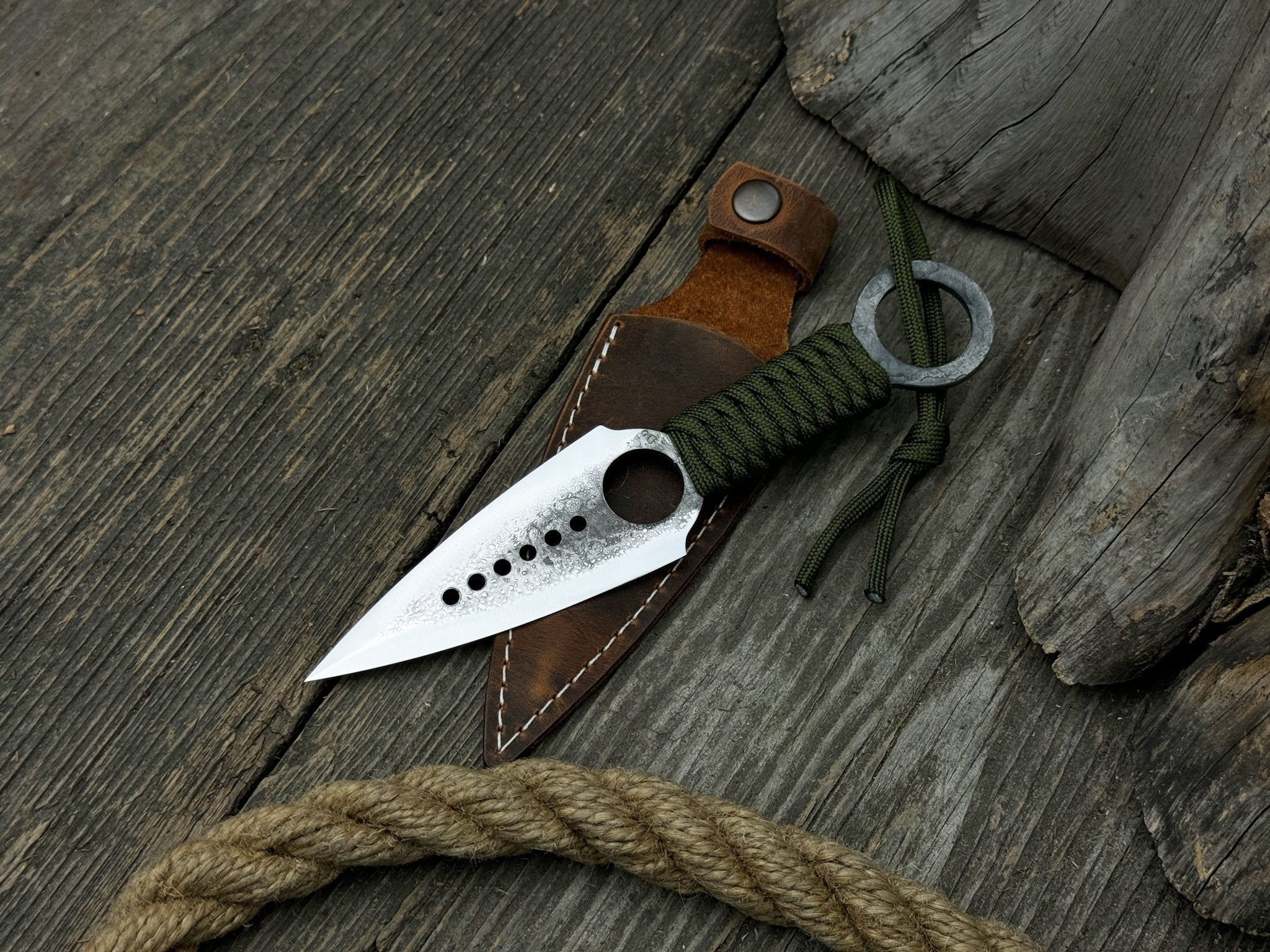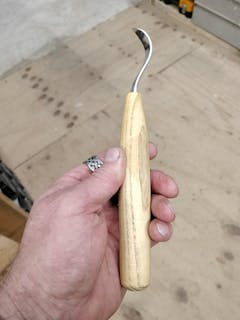Hand-Forged Throwing Knife, 23 cm (9 inches)
Hand-Forged Throwing Knife, 22 cm (8.6 inches)
3-Piece Hand-Forged Throwing Knife Set, 22 cm (8.6 inches)
Hand-Forged Throwing Knife, 16 cm (6.3 inches)
Throwing Knife with Leather Sheath, 16 cm (6.3 inches)

Hand-Forged Throwing Knife – 23 cm (9 in) with Leather Belt Sheath
Hand-Forged Throwing Knife with Leather Belt Sheath, 19 cm (7.48 inches)
Hand-Forged Throwing Knife with Leather Belt Sheath, 16 cm (6.3 inches)
Leather Case for 3 Throwing Knives
The Art of Knife Throwing: A Timeless Skill
The origin of knives for throwing is closely connected to advancements in metalworking. As metal became widespread in early human civilizations, throwing knives emerged in hunting, martial arts and the military. Egyptians, Romans, and Chinese cultures incorporated them into their arsenals. In Egypt, the knives had leaf-shaped blades, while Chinese knives stood out for their intricate handle designs that improved grip. Romans crafted spearhead-shaped knives for combat.
In addition to combat, throwing knives were also used in rituals and ceremonies to demonstrate the skill and bravery of knife throwers. In Japanese culture, throw knives were weapons used by samurai warriors and have since been romanticized in popular culture.
As different types of throwing knives grew in popularity, specialized techniques were developed to improve their accuracy, with particular focus on achieving balance through proper weight distribution. During the Middle Ages, knives for throwing became favored weapons among warriors for close combat and stealthy, long-distance attacks.
By the 19th century, the knives transitioned into recreational use, especially in competitive sports, as firearms became more prominent. Today, knife throwing attracts various groups of enthusiasts. Some engage in it as a competitive sport, others as a leisure activity. Many appreciate its historical context and collect antique knives, while some practice it as a form of stress relief and concentration practice.
Choosing the Perfect Throwing Knife
Blade Materials: What Works Best for Throwing
Getting started by determining the purpose of your knife throwing is the best approach.
If you’re aiming to participate in knife throwing league tournaments, familiarize yourself with the organization’s requirements before you buy throwing knives. There are specific knife specifications outlined in the guidelines that all participants must adhere to.
For recreational use, you have more options to choose from. In this case, consider your personal preferences and types of throwing you would like to practice. If you are new to knife throwing, consult resources such as Blade Magazine, which has covered the knife industry since 1974, for tips on choosing the best throwing knives.
The first criterion in determining the quality of professional throwing knives is steel. Some of the most popular steels include:
Stainless Steel:
- Hard Stainless Steel: Often used in affordable knives, it is corrosion-resistant but tends to crack or snap under repeated impacts against a knife target.
- Soft Stainless Steel: More durable than hard stainless steel, but prone to nicks. These knives require regular maintenance, such as filing down burrs and dents.
High Carbon Steel:
- Common in custom knives and often referred to as ‘spring steel’, this material is extremely durable, holds a sharp edge, and handles impacts well. However, it is prone to corrosion, so oiling is necessary to prevent rust. Pay attention to the hardness level. While 1095 steel holds a sharp edge, it can be brittle and prone to chipping. 1055 steel doesn’t maintain the edge as efficiently but is softer, so a better hardness standard for throwing knives is often 1075.
D2 Steel:
- Frequently used in throwing knives, as it is popular for its high strength and corrosion resistance. It offers durability similar to high carbon steel but is less prone to corrosion. However, it is more expensive and harder to work with.
Key Features to Look for in a Throwing Knife
Best throwers can make almost anything with a sharp point stick in a target, but with the right tools, this task becomes way easier. So, what features make professional throwing knives an excellent choice? Here are a few major criteria:
- Combined Shape and Design: The combined shape of the knife - blade and handle - should promote smooth flight and stability. Features like a tapered point and streamlined body help reduce air resistance. Simple blade shapes are crucial for consistent throws, as extra decorative elements may affect the knife’s aerodynamics and balance.
Construction:
- Full-Tang Construction: The blade and handle are made from a single piece of metal. This construction makes throw knives more durable and resistant to chipping.
- One-Piece Construction: The entire knife, including blade and handle, is forged from one piece of metal. This simplifies the knife, prevents breakage at the joint, ensures better weight distribution, and enhances stability during throws.
- Blade/Handle-Heavy Construction: These knives have either a heavier blade or handle, causing them to spin differently. Blade-heavy knives are perfect for beginner throwers, as they spin naturally when thrown from the handle. Heavy-handle knives are designed for advanced throwers who prefer to throw from the blade. This construction is very popular with the best throwers, practicing no-spin throws.
- Blade Shape and Sharpness: When looking for the best knives for throwing, the blade should be sharp enough to stick in the knife target but not so sharp that it becomes dangerous to handle.
Understanding Knife Balance and Weight
Best throwing is achieved when knives for throwing have the right combination of balance, weight, and length. These factors are interconnected and depend on the type of throwing you intend to practice:
- Balance:
The idea that a perfectly balanced knife has its center of mass exactly in the middle is outdated. Balance depends on whether throwing knives are made for blade-first or handle-first throwing. As mentioned, handle-throwing knives are weighted toward the blade, while blade-throwing knives are weighted toward the handle. Some knives are balanced at the center, allowing them to be thrown either way. All knives can be well-balanced if knife throwers practice enough to understand and adapt to each knife’s unique balance.
- Weight:
Lighter and smaller knives are not the best options for throwing, as they lack the necessary weight, require more force, and can be unpredictable in flight. A good starting weight for beginners is around 200g. Knives for longer distances (5m or more) should weigh at least 250g, while heavier knives (400g and more) require more skill and practice to handle effectively. Most throwing knives weigh between 283-454 g (10-16 ounces).
- Length:
Longer knives rotate more slowly, making them suitable for beginners. Usual knife lengths range from 25 to 38 cm (10-15 inches), with 31-36 cm (12-14 inches) being recommended for novice throwers.
Maintaining and Caring for Your Throwing Knives
To properly care for your knives for throwing, follow these steps:
- Cleaning: Wipe down knives for throwing after each session with a wet cloth to remove marks. Dry them thoroughly to prevent oxidation. Avoid using soap or other detergents, as they may damage the knife’s coating.
- Oiling: After cleaning, lightly oil the knives. Mineral oils are effective for preventing rust.
- Storage: Store knives on a magnetic rail, in a traditional knife block, or in a drawer. Avoid storing them in leather sheaths, as leather absorbs moisture, which can damage both the knife and the sheath. If using leather sheaths, apply a preservative or mink oil to maintain them.
- Sharpening and Repairs: If your knife has dents, use a sharpener or whetstone to fix them. Regular sharpening is essential for maintaining proper performance. If sharpening seems hard to learn, seek for advice from professional forums, YouTube or Blade Magazine.
Explore Our Collection of High-Quality Throwing Knives
At Sharky Forged Steel Tools™, our entire selection of throwing knives is hand-forged from robust 52100 high-carbon steel, known for its precision and durability. Each knife is ready to use out of the box, featuring cord-wrapped handles for superior grip.
When you buy throwing knives from us, you will benefit from:
- Reduced need for frequent replacement due to the steel’s longevity and the durability of cord-wrapped handles.
- Versatility, perfect for enthusiasts of all skill levels. Our knives range from 15 to 22.5 cm (5.9-8.8 inches), so you can choose the size with the balance right for your throwing skill and technique.
- Affordable prices and trackable worldwide delivery, offering excellent value without sacrificing quality.
Experience the difference with Sharky Forged Steel Tools™ and elevate your knife-throwing game!





























